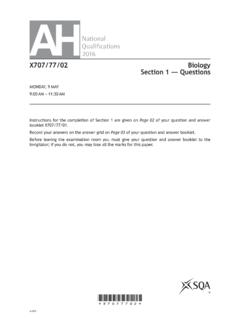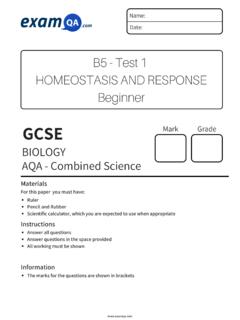Transcription of Models for Battery Reliability and Lifetime
1 NREL is a national laboratory of the Department of Energy, Office of Energy Efficiency and Renewable Energy, operated by the Alliance for Sustainable Energy, LLC. Models for Battery Reliability and Lifetime Applications in Design and Health Management Kandler Smith Jeremy Neubauer Eric Wood Myungsoo Jun Ahmad Pesaran Center for Transportation Technologies and Systems National Renewable Energy Laboratory NREL/PR-5400-58550 Battery Congress April 15-16, 2013 Ann Arbor, Michigan NATIONAL RENEWABLE ENERGY LABORATORYB etter life prediction methods, Models and management are essential to accelerate commercial deployment of Li-ion batteries in large-scale high-investment applications2 End User Goals: Understand Reliability and economics of new technologies ( , electric-drive vehicles vs. conventional vehicles) Manage assets for maximum utilization ( route scheduling, charge control to optimize EV fleet life and cost)OEM Goals: Optimize designs (size, cost, life) Minimize business & warranty risk Reduce time to market*Source.
2 Marc Isaacson, Lockheed MartinTime-to-market vs acceptable risk for satellite Battery industry*NATIONAL RENEWABLE ENERGY LABORATORYNREL Research & Development Addressing Battery Lifetime3No coolingAir coolingAir cooling, low resistance cePhoenix, AZ ambient conditionsLiquid coolingLife predictive modeling and Battery system tradeoff studiesComputer-aided engineering of batteries (CAEBAT program) Battery health estimation & management (Laboratory-Directed R&D program) Battery prognostic and electrochemical control (ARPA-E AMPED program)Life scenarioanalysisRelative Capacity (%)3D Multi-physics simulationAging modelOnline & offline health tracking of real-world applicationsAdvanced Battery management R&D with industry & university partnersNATIONAL RENEWABLE ENERGY LABORATORYO utline4 Part 1: Battery Life Modeling Life Model Framework NCA Model FeP ModelPart 2: Life Model Application Life-Cycle Analyses Real-Time Health ManagementNATIONAL RENEWABLE ENERGY LABORATORYNREL Life Predictive ModelRelativeResistanceRelativeCapacity Data shown above: Hall, IECEC, c0+ c2 NQsites= c0+ c2NR = a1 t1/2+ a2 NCalendar fade SEI growth (possibly coupled with cycling) Loss of cyclable lithium a1, b1= f( DOD,T,V)Q = min ( QLi , Qsites )QLi= b0+ b1 t1/2+ b2 NQLi= b0+ b1 t1/2+ b2 NCycling fade Active material structure degradation and mechanical fracture a2, c2= f( DOD,T,V)5 Relative Capacity (%)Time (years)r2= NCA chemistryResistance Growth (m )Arrhenius-Tafel-Wohler model describing a2( DOD,T, V)NCANATIONAL RENEWABLE ENERGY LABORATORYLife model framework: Graphite/NCA example6 Relative Capacity (%)NCAA.
3 Resistance growth during storageBroussely (Saft), 2007: T = 20 C, 40 C, 60 C SOC = 50%, 100%B. Resistance growth during cyclingHall (Boeing), 2005-2006: DoD = 20%, 40%, 60%, 80% End-of-charge voltage = , , V Cycles/day = 1, 4C. Capacity fade during storageSmart (NASA-JPL), 2009 T = 0 C, 10 C, 23 C, 40 C, 55 CBroussely (Saft), 2001 V = , Capacity fade during cyclingHall (Boeing), 2005-2006: (see above)Data1. Fit local model(s)2. Visualize rate-dependence on operating condition3. Hypothesize rate-law(s)4. Fit rate-laws(s)5. Fit global model(s)Regression refaTTtTRE1)(1exp refrefocVTVtTtVRF)()(exp refDoDDoDDoDNCAPHEV10 PhoenixPredictive modelSelect model with best statisticsNATIONAL RENEWABLE ENERGY LABORATORYKnee in curve important for predicting end of life7 Example simulation: 1 cycle/day at 25 C 50% DOD:Graceful fade(controlled by lithium loss)(Hypothesis based on observations from data)80% DOD:Graceful fade transitions to sudden fade ~2300 cycles(transition from lithium loss to site loss)Life over-predicted by 25% without knee NCANATIONAL RENEWABLE ENERGY LABORATORYIron-phosphate (FeP) Life Model8 Estimated $2M data collection effort of other labs has been leveraged for this analysis (DOE, NASA-JPL, HRL & GM, Delacourt, CMU, IFP)Capacity fade with knee region highlightedFePA123 ANR-26650-M1 LixC6/LiyFePO4 Ah, RENEWABLE ENERGY LABORATORYA ctive site loss controlled mainly by mechanical-driven cycling fade9 Hypothesis for active site loss dependence on operating parameters.
4 C-rate (intercalation gradient strains) DOD (bulk intercalation strains) Low T (exacerbates Li intercalation-gradients) High T (exacerbates binder loss of adhesion) T (thermal strains)NATIONAL RENEWABLE ENERGY LABORATORYH ypothesized Active Site Loss Model10 Blue symbols are site-loss rates for each individual aging conditionPurple symbols are global rate-law model across all aging conditionsSite loss/cycle, log(c2) .expexp,, ,22 refpulsepulserefrateraterefarefattCCTTET TRE refmTmDODmcc).,min(sitesLiqqq NbtbbqzLi210 DODN ccqsites20 accelerated binder failure at high Tbulkintercalationstrainbulkthermalstrai nintercalation gradient strain, accelerated by low temperature FePNATIONAL RENEWABLE ENERGY LABORATORYFeP model comparison with knee data11 Global model compared with13 aging conditions from 0 C to 60 CActive site loss (at room temperature, 1C charge/discharge, 100% DOD reference conditions) 83% due to bulk volumetric expansion/contraction of the active material* 13% due to particle fracture owing to intercalation stress at high C-rates 4% due to temperature swings encountered by the cellFeP* This dominant aging term correlates with Amp-hour throughput, often used as a proxy for agingNATIONAL RENEWABLE ENERGY LABORATORYO utline12 Part 1: Battery Life Modeling Life Model Framework NCA Model FeP ModelPart 2.
5 Life Model Application Life-Cycle Analyses Real-Time Health ManagementNATIONAL RENEWABLE ENERGY LABORATORYA utomotive Analyses: Battery Ownership Model13 Objective: Identify cost-effective pathways to reduce petroleum use and carbon footprint via optimal use of vehicular energy storage systemsApproach: Trip-by-trip simulation of hundreds of real-world, year-long, vehicle-specific drive patterns in real climates Model driver behavior, road loads, auxiliary loads, vehicle cabin thermal response, and Battery electrical, thermal, and life responseLife ModelNATIONAL RENEWABLE ENERGY LABORATORYM inneapolis, MNLos Angeles, CAPhoenix, AZPhoenix, AZLos Angeles, CAMinneapolis, MNMinneapolis, MNLos Angeles, CAPhoenix, AZPhoenix, AZLos Angeles, CAMinneapolis, MNAutomotive Analyses: Battery Ownership Model14A recent study of climate, trip history, and driver aggression shows how these factor affect Battery state of health after 10 years in a BEV75- 317 different real-world trip histories- 3 different driver aggression levels- 3 different climates-Findings: Climate has the largest effect on Battery wear, followed by trip historyNATIONAL RENEWABLE ENERGY LABORATORYB attery Second-Use Analyses15 Battery state of health is critical to determining the technical capability and performance of a second-use batteryOur second-use analyses incorporate the life model to calculate a health factor that becomes a major determinant in second-use feasibility0%20%40%60%80%100%0%9%18%27%3 4%41%Fraction of Drive PatternsSecond Use Health FactorBEV75 PHEV35(kH)Life ModelSecond-Use Battery Selling Price = kU kHcNNATIONAL RENEWABLE ENERGY LABORATORYGrid Analyses.
6 Community Energy Storage16 Analyzed the long-term effects of two different community energy storage system configurations in a real-world climate Tomb configuration: insulated from ambient temperature and solar irradiation, strong connection to soil temperature. Greenhouse configuration: Strong connection to ambient temperature, large effect of irradiation. Duty Cycle: Daily 60% DOD peak-shaving event Climate: Los Angeles, CA Findings: The difference in long-term wear between the two system configurations is small for this combination of climate and duty cycleTime (days)Resistance (%)Capacity (%)NATIONAL RENEWABLE ENERGY LABORATORYTime-scales: Control & Estimation1710-3100103106109 Application[seconds]Side reaction limitsPrognostic-based chargingControlPrognostic-based V2 GAvailable powerAvailable energyParticle stress limitsHealthRemaining lifeEmbedded controlNREL PIX 19358 PerformanceNREL PIX 19243 CommuteNREL PIX 24515 NREL PIX 20040 NREL PIX 18660 Figure: Dean ArnmstrongNREL PIX 10928 ChargeEnvironmentGrid2ndUseNREL PIX 20041 NREL PIX 10925 Figures: Vetter, J.
7 Power Sources (2005) NREL PIX 19243 NATIONAL RENEWABLE ENERGY LABORATORYA lgorithm topologyI,V,TdataSOHestKalman or particle filterLife modelRecursive regressionSOCestPerformance model(s)RULestTime ScaleSOPestSOP = state of powerSOC = state of chargeSOH = state of healthRUL = remaining useful lifeNATIONAL RENEWABLE ENERGY LABORATORYD iagnostic Example (online)19 Particle filter + circuit model: Estimates both SOC & capacity within 2% of actualVocv(SOC,Q)NATIONAL RENEWABLE ENERGY LABORATORYD iagnostic Example (vehicle fleet analysis)20 Date (mm/yy)ResistanceCapacityDate (mm/yy)Figure credits: Eric WoodDiagnostic Analysis Tools also being applied to EV MD delivery vehicle fleet (200+ vehicles, ~ yrs data) Hybrid fuel cell vehicles (40 vehicles, ~5 yrs data)Validation of algorithm withSCE/Saft Lab DataEstimation of Total Capacity and DC Resistance using in-service (partial discharge) I,V,T dataNATIONAL RENEWABLE ENERGY LABORATORYARPA-E AMPED: Three Projects in Battery Management21 Utah State/FordProject: 20% reduction in PHEV pack energy content via power shuttling system and control of disparate cells to homogenous end-of-lifeNREL: Requirements analysis; life model of Ford/Panasonic cell; controls validation of Ford PHEV packsEaton CorporationProject: Downsized HEV pack by 50% through enabling Battery prognostic & supervisory control, while maintaining same HEV performance & lifeNREL: Life testing/modeling of Eaton cells.
8 Controls validation on Eaton HEV packsWashington : Improve available energy at the cell level by 20% based on real-time predictive modeling & adaptive techniquesNREL: Physics-based cell-level Models for MPC; implement WU reformulated Models on BMS; validate at cell & module levelAdvanced Management and Protection of Energy Storage Devices Develop advanced sensing and control technologies to provide new innovations in safety, performance, and Lifetime for grid-scale and vehicle RENEWABLE ENERGY LABORATORYS ummary22 Capable Battery life Models can be built today, but rely heavily on empirical life test of life Models can be used to optimize design (offline) and maximize asset utilization (online).NREL is pursuing Battery life Models with physics-based descriptions of degradation mechanisms that could both reduce time-to-market and advise longer-life cell RENEWABLE ENERGY LABORATORYA cknowledgments23 DOE Vehicle Technologies Brian Cunningham David HowellUS Army/TARDEC Yi DingDOE ARPA-E Ilan GurNASA Jet Propulsion Laboratory Marshall SmartIdaho National Laboratory Kevin GeringHRL Labs John Wang, Ping LiuUniversit de Picardie Jules Verne Charles DelacourtBoeing John C.
9 HallS. California Edison Naum Pinsky, Loic Gaillac











